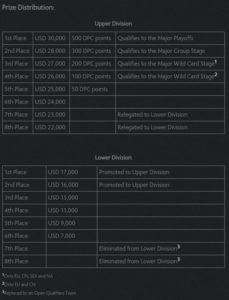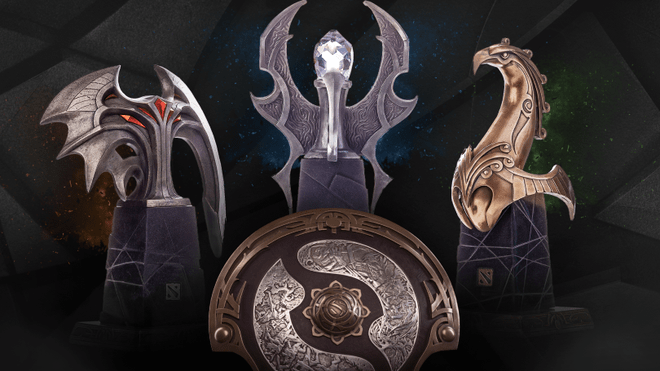Already a few weeks ago, the customer spread the valve for the coming Dota2 season a major format change plans. Now the publisher published the details of the upcoming Dota2 season.
In the past Valve was often under heavy criticism for the implementation of the competitive scene. On the one hand the event “The International” was highly praised, which set new records in terms of prize money year after year – 34.330.068$ prize pool in 2019. But on the other hand exactly this extreme focus on the mega event made sure that especially in the Tier 2 scene neither money nor publicity was available. So the motto of the last years was often all or nothing. A winner at the TI could win millions, while not qualifying could not mean a cent of effort for a year.
To overcome this problem, Valve now announced the new format of regional leagues. This will come into force from September, after The International 10.
Six regional leagues
In the coming season, there will not be five Major and Minor Events, as before, for which the teams could qualify via Online Qualifier. They will now be replaced by six regional leagues – Europe, CIS, NA, SA, SEA, China. Each of the regional leagues will have a prize pool of $280,000 and will culminate in a seasonal Major Tournament, with another $500,000 in prize money. A total of 3 seasons will be played – Fall, Winter, Spring – followed by The International in August.
Currently, 5 major/minor is prizepool of 6.5mil.
With new system, 280k*6regions*3seasons is 5mil. Add three 500k majors and we end up with same value of 6.5mil.
First season of DPC was 3mil majors three times a year (9mil).
Distribution change is good. Budget is not.
— SunBhie (@SunBhieDota) February 26, 2020
The regional leagues are divided into an Upper Division and a Lower Division with 8 teams each. The leagues are played in the best-of-3 round-robin system. This means that each team will play once against each other in Bo3. At the end of a season, the two lowest ranked teams from the Upper Division will be relegated and replaced by the Top 2 from the Lower Division. From this division the last two places will be replaced by Open Qualifer Teams.
Glad to see Valve taking dota in this direction. Great for t2/t3 scene and will also be better for everyone in the long term https://t.co/8x1dE432Id
— Tal Aizik (@talflyaizik) February 26, 2020
The format of the Majors tournaments will also change as a result. A total of 18 instead of 16 teams will qualify for these tournaments. Here, the first-placed team from each region will start directly in the winner’s bracket of the playoffs, while the runners-up will compete in a group phase against the other runners-up and two wildcard teams. The wildcard places will be made up of the third and fourth places from each region. Therefore a strong performance in the regional leagues is important for a good start on the major.

As before, there are so-called DPC points for the performance on the Major, as well as in the league. At the end of all 3 majors, the top 12 teams with the most DPC points will be invited directly to The International, while the last six places will be awarded by qualifiers.
A long time coming! Bravo to everyone working bts to make this happen. Excited to finally see the return of the league structure and how it will benefit not just the teams but the community. Dota is beautiful, may it never die! 🙏 https://t.co/aCLNpoOpp1
— Evany Chang (@the_evany) February 26, 2020
In addition, Valve also stipulated that at the beginning of a season the region in which a team would like to compete must be announced. Three of the five players must be resident in the respective region. A change of region is possible, but requires a start in the lower division and qualification through the Open Qualifers.
Getting used to it for everyone
With these changes Valve wants to give more structure to regions that have been rather weak so far. The prize money in the league phases prevents so-called gatekeeping. As a result, the same teams qualified and won prize money again and again in certain regions, while Tier 2 teams had little chance of success. The prize money distribution in the Lower Division now ensures that even weaker teams are rewarded at the end of the season.
I think this is the most positive I have felt about a DPC change announcement.
Of course there will be challenges in execution & those affected by change. https://t.co/hLRdNX0ujt
— Inactive (@TobiWanDOTA) February 26, 2020
On the other side of the coin, these changes result in a much flatter prize money distribution.
Although the total prize money over a season – $6.5 million – has remained the same, the large scale distribution over six regions and three majors means that the winner of the Upper Division will only receive $30,000. A win on the next major is then rewarded with another $200,000, which is significantly less than the previous prize of almost $500,000.
New dpc system looks like garbage. I don't know what people are excited about.
— Heen (@Heen1337) February 26, 2020
Another drawback was brought to light by Matthew “Cyborgmatt” Bailey. Due to the long league phase, as well as the following Major Finals, it will be difficult for so-called Thirdparty Organisation to organise suitable tournaments. This could result in a year with the at least lans since the release of Dota2. While the changes will be of great benefit for casters and Tier 2&3 teams, the changes in prize money and time management could have a negative impact on the top organization.
Extremely concerned about this calendar, with none DPC events only being allowed to run outside of these dates we may have the least amount of LAN events in Dota ever next season.
Be prepared to only see some of the top tier teams at 3 LANs before TI. pic.twitter.com/A5nP2lLptp
— Matthew Bailey (@Cyborgmatt) February 26, 2020
Questions about the transfer also remain unclear. Valve announced that all Upper Division games will be broadcast and all Lower Division Maches will be shown on DoaTV. Who exactly is responsible for the broadcasts and if this means that Upper Division matches will not be visible on DotaTV is still open.


